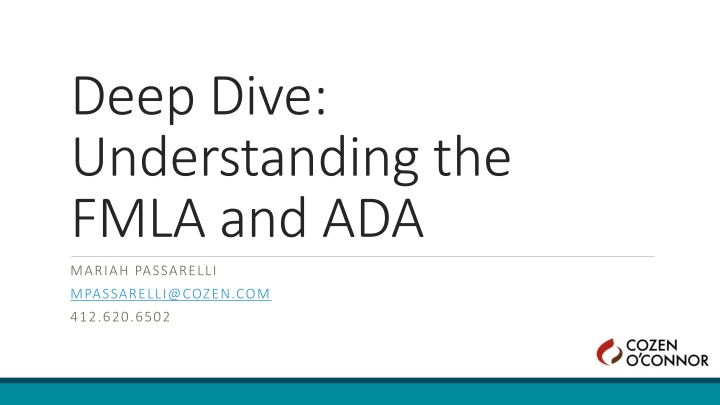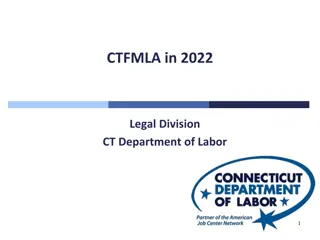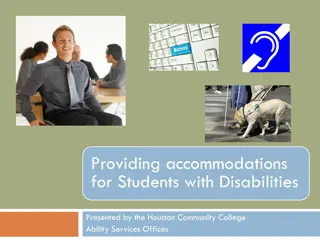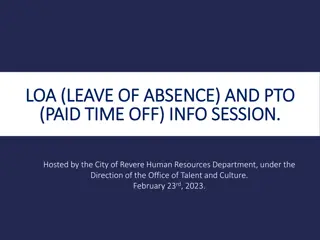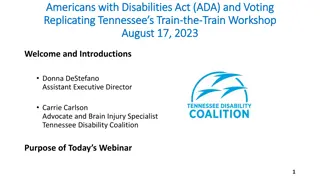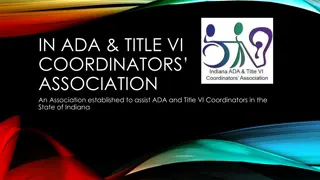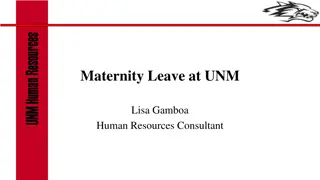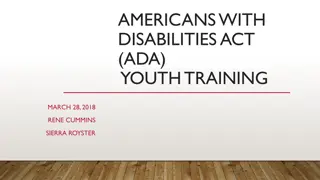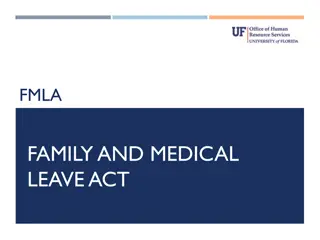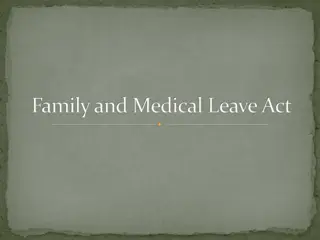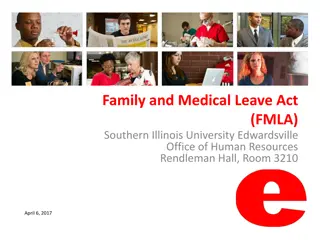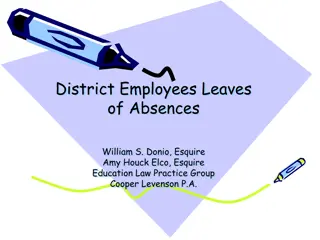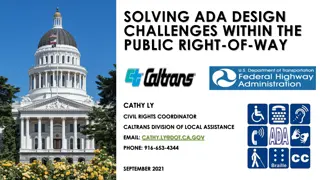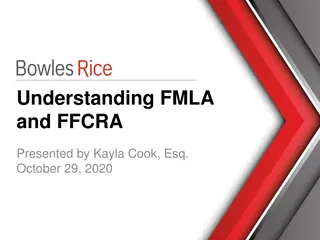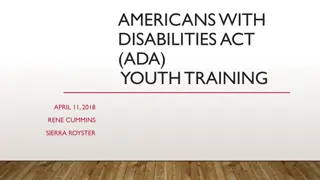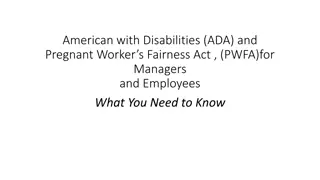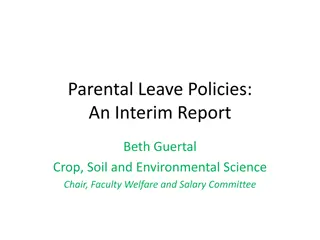In-Depth Look at FMLA and ADA Compliance: Best Practices and Challenges
Explore the complexities of ADA and FMLA compliance, including remote work, job transfers, and reasonable accommodations. Learn about FMLA legal background, types of leave, coverage requirements, and qualifying events for FMLA leave.
Download Presentation

Please find below an Image/Link to download the presentation.
The content on the website is provided AS IS for your information and personal use only. It may not be sold, licensed, or shared on other websites without obtaining consent from the author.If you encounter any issues during the download, it is possible that the publisher has removed the file from their server.
You are allowed to download the files provided on this website for personal or commercial use, subject to the condition that they are used lawfully. All files are the property of their respective owners.
The content on the website is provided AS IS for your information and personal use only. It may not be sold, licensed, or shared on other websites without obtaining consent from the author.
E N D
Presentation Transcript
Deep Dive: Understanding the FMLA and ADA MARIAH PASSARELLI MPASSARELLI@COZEN.COM 412.620.6502
Goals While the Family Medical Leave Act ( FMLA ) and Americans with Disabilities Act ( ADA ) are now familiar territory for most employers, they continue to present challenges (and significant litigation risk) The goal today is to take a more in-depth look at ADA and FMLA compliance, including best practices for navigating the trickier issues of remote work, job transfer, and time off as reasonable accommodations
Family and Medical Leave Act (FMLA) Provides unpaid, job-protected time off for qualifying employees under qualifying circumstances Prohibits employers from interfering with right to leave Prohibits discrimination against employees who have requested and/or taken FMLA leave Prohibits retaliation against employees who have requested and/or taken FMLA leave requesting and/or taking FMLA leave
Types of FMLA Leave There are two types of FMLA leave: Contiguous = FMLA leave taken in blocks of continuous time; and Intermittent = FMLA leave taken in smaller increments of time (partial hours, hours, days) over the course of weeks or months
FMLA Coverage Requires three things: 1. Covered employer 50 or more Team Members 2. Eligible Team Member Work at a location where there are 50 or more employees within a 75-mile radius Work for employer at least 12 months total Work at least 1,250 hours in the 12 months prior to leave 3. Qualifying event
FMLA Coverage Qualifying event Event Amount of Leave Pregnancy and birth Up to 12 weeks block or intermittent Parental bonding Up to 12 weeks block Care for spouse, child, parent with serious health condition Up to 12 weeks block or intermittent Own serious health condition Up to 12 weeks block or intermittent Military caregiver Up to 26 weeks block or intermittent Military exigency Certain specified periods
Qualifying Events Rules for pregnancy or birth Pregnancy is not, itself, a serious health condition However, incapacity due to pregnancy, absences for pre-natal care, and absences due to serious health conditions following birth are covered by the FMLA Spouse is entitled to FMLA leave to care for pregnant woman meeting one of the criteria above
Qualifying Events Rules for parental bonding Must be taken within 12 months of birth or placement Employer has discretion to require that it be taken in a continuous block (as opposed to on an intermittent basis) If both parents are employed by Company, their time off is limited to 12 weeks combined for birth and bonding
Qualifying Events Rules for a spouse, parent, or child s serious health condition: Limited to spouse, child, or parent Child now includes concept of in loco parentis Must have a qualifying serious health condition May be taken on a block or intermittent basis Rules for employee s own serious health condition: Must have qualifying serious health condition May be taken on a block or intermittent basis
Qualifying Events What is a serious health condition? Defined as an illness, injury, impairment or physical or mental condition that involves inpatient care or continuing treatment by a health care provider Inpatient care = An overnight stay in a hospital, hospice, or residential medical care facility; or Continuing treatment = Incapacity + Treatment Treatment for chronic/permanent conditions Conditions requiring multiple treatments
Qualifying Events Incapacity = inability to work, attend school, or perform other regular daily activities due to a serious health condition, treatment therefore or recovery therefrom Treatment includes (but is not limited to) examination to determine if a serious health condition exists and evaluation of the condition Treatment also includes a course of prescription medication and/or therapy Treatment for substance abuse is a serious health condition
In Real Life What this means is that a whole host of physical and mental conditions qualify an employee for FMLA leave Responsibility for getting this right ultimately rests with the Company and, essentially, lives or dies with the supervisors Under the law, the Company has a legal obligation to identify and respond to qualifying events
What about COVID? EEOC guidance from the pandemic remains in effect Employees experiencing COVID symptoms or testing positive for COVID are likely considered to have an FMLA-qualifying serious health condition Consider imposing testing requirements
FMLA Procedures: Triggering Event The employer must begin the FMLA process when any one of the following triggering events occurs: (1) The employee requests FMLA leave (in writing or orally); (2) The employee has called off sick from work for 3 consecutive shifts; (3) The employee reports the need to be absent from work in the future due to their own health or the health of their spouse, child, or parent for 3 consecutive days; or (4) The employer becomes aware of an FMLA-qualifying reason (e.g., upcoming surgery, therapy appointments)
FMLA Procedure Pitfalls Employers notoriously miss the boat on spotting triggering events Supervisors (and HR) must be trained on FMLA triggers and resist the urge to require an employee to use magic words
FMLA Procedures: The Deadline Trap After a triggering event occurs, a series of FMLA-imposed deadlines begin to run Failure by the employer to meet the employer-related deadlines can result in liability on an FMLA interference claim While, at the same time, strict enforcement of the employee- related deadlines can result in liability on an FMLA interference claim
FMLA Procedures: Eligibility Within 5 days of a triggering event, the Company must notify the employee whether or not he/she is eligible for FMLA leave (different from approved)
FMLA Procedures: Eligibility If the Company determines that the employee is eligible for FMLA leave, the Company must then provide the employee with: Certification form (issued by the Department of Labor; to be completed by the employee s healthcare provider or the family member s health care provider (where applicable)) Job description (if leave is based on employee s own serious health condition)
FMLA Procedures: Certification Employee has 15 days to return the completed FMLA Certification However, the Company must extend this period of time if, for instance, the delay is outside the employee s control
Caution: Do not discipline or terminate an employee for failure to meet the initial certification return deadline. Indeed, FMLA time can be applied retroactively once approved.
FMLA Procedures: Certification Upon receipt, the Company reviews the FMLA Certification for completeness, sufficiency, and authenticity Incomplete = not signed or one or more of the entries is not completed Insufficient = information provided is vague or non-responsive If the Certification is incomplete and/or insufficient, the Company must inform the employee in writing, specifying what information is needed; employee must have Certification corrected within 7 days (subject to extension)
FMLA Procedures: Certification If the authenticity of the Certification is in question, the Company can contact the health care provider This contact cannot come from the employee s immediate supervisor This contact must be confined to clarifying the health care provider s handwriting, clarify the meaning of information thereon, and/or confirm that they completed the Certification
Caution: Supervisors should not discuss the employee s health condition (or the particulars of the employee s FMLA request) with the employee. Ever.
FMLA Procedures: The Decision The Company must inform the employee of the approval/denial decision using a fully-completed FMLA Designation Notice (issued by Department of Labor) within 5 business days after the employee submitted the sufficiently completed Certification
FMLA Procedures: Calculating Leave The employee s FMLA leave balance is calculated using the employee s typical schedule E.g., If the employee typically works 8 hours per day, 5 days per week, then 40 hours of intermittent leave constitutes 1 week of FMLA leave Intermittent leave increments must be as small as other policies allow (i.e., the employee cannot be required to take half-days or full days of FMLA if the employee would be able to take smaller increments of PTO)
Caution: The Company cannot do anything that would be seen as accelerating an employee s use of FMLA leave.
FMLA Procedures: Recertification The Company may request recertification: If the employee s originally approved leave period is longer than six (6) months, Company can request recertification every six (6) months If the employee s originally approved leave period is shorter than six (6) months, Company can request recertification at the end of the approved leave period If the employee s FMLA leave use is deviating from the Certification If the Company has reason to believe the employee s FMLA leave use is fraudulent (take extreme caution here)
Caution: Playing private eye, judge, or jury with regard to suspected fraud almost always leads to liability risk.
FMLA Procedures: Job Restoration When an employee returns from a period of FMLA leave, they are legally entitled to be restored to their previous position This means, if the Company has back-filled an employee s position in their FMLA-related absence, the Company must un- backfill it (even if everyone likes the new person more!)
Caution: More on this in the ADA section, but be advised that we cannot automatically terminate (or threaten to terminate) an employee in need of additional leave after FMLA is exhausted!
FMLA Legal Claims There are three types of legal claims arising from the FMLA: 1. FMLA interference 2. FMLA discrimination/harassment 3. FMLA retaliation The Company is responsible for: The conduct of supervisors (with limited exception) Mistakes made in administering FMLA leave The misconduct of co-workers when left un-checked
FMLA Interference Any time the Company makes a mistake with regard to the FMLA procedures, it has committed interference The impact (and the available damages) depends upon what happens as a result If, for instance, the Company denies an FMLA leave request because the employee is late with their paperwork and the employee is terminated based on the Attendance Policy as a result, the damages could be significant If the Company misses a deadline, but approves FMLA leave, while a technical violation, there are no damages
FMLA Discrimination/Harassment An employee is protected against FMLA discrimination as soon as they request FMLA leave and/or otherwise place the Company on notice of the need for FMLA leave The FMLA prohibits the Company from discriminating against that employee on the basis of their FMLA leave request/status
FMLA Retaliation An employee becomes protected against FMLA retaliation as soon as the employee requests FMLA leave Retaliation = Any adverse employment action that happens to the employee because the employee asked for and/or used FMLA leave
Caution: Carefully review performance reviews and disciplinary documentation for employees who have recently been on/requested FMLA leave. Remarks on reliability, attendance, etc. could give rise to legal liability risk.
Americans with Disabilities Act (ADA) Prohibits discrimination against: Qualified individuals with disabilities Individuals with a history of disability Individuals regarded as having a disability Individuals associated with a family member with a disability Requires employers to make a reasonable accommodation for the known disability of a qualified applicant or employee Prohibits retaliation against an individual who, among other things, requests/uses a reasonable accommodation
Disability Defined Disability = a physical or mental impairment that substantially limits one or more major life activities and/or major bodily functions Major life activities = caring for oneself, performing manual tasks, seeing, hearing, eating, sleeping, walking, standing, lifting, bending, speaking, breathing, learning, reading, concentrating, thinking, communicating, and working Major bodily functions = functions of the immune system, normal cell growth, digestive, bowel, bladder, neurological, brain respiratory, circulatory, endocrine, and reproductive functions
ADA Procedures: Issue Spotting When an employee requests a reasonable accommodation and/or reports a physical or mental condition that impacts their job performance (including attendance), the Company is on notice of a potential ADA issue Once on notice, the Company must engage in the interactive process
ADA Procedures: The Interactive Process The interactive process involves the Company and the employee engaging in good-faith communications to determine: Whether the employee has an ADA-qualifying disability; and If so, whether the employee can perform the essential functions of the employee s job, with or without reasonable accommodation
A Word on Job Descriptions Whether or not a restriction constitutes a reasonable accommodation under the ADA turns on the essential functions of the employee s job, as set forth in the employee s job description In other words, this is not an analysis of whether a particular supervisor thinks the request is reasonable, as that word is commonly used
ADA Procedures: Reasonable Accommodation The Company engages in the interactive process through the use of an ADA Questionnaire When the Questionnaire is returned, the Company evaluates reasonable accommodations Reasonable accommodations can include: Change job tasks Modify physical workspace or equipment (including parking) Change testing materials for applicants Reassign employee to a vacant position Time off from work
What is not reasonable Indefinite or moving-target time off from work Removal of essential job functions (where those functions cannot be easily assumed by others)
Caution: If an employee does not request leave, the Company must evaluate job transfer opportunities before forcing the employee to take leave as an accommodation.
ADA Procedures: Job Transfer When an employee wants to continue to work (does not request leave) but cannot perform the essential functions of the employee s job, with or without reasonable accommodation: The Company must consider whether there is an available position for which the employee qualifies, in which the employee could perform the essential functions; and If there is such an open position, the Company must transfer the employee to that position (making reasonable accommodations if necessary). This transfer can be temporary or permanent, depending upon the nature of the employee s condition
ADA Procedures: Leave Often times, an employee requests leave or is unable to perform any available job with or without other reasonable accommodation Leave (i.e., time off from work) is a type of reasonable accommodation There is no hard and fast rule regarding duration, but periods of up to one (1) year appear acceptable in the 3rdCircuit Leave may take the form of modified work schedule and/or continuous blocks of time off
